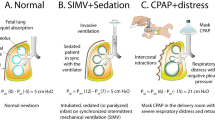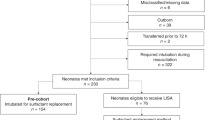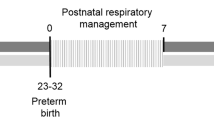Abstract
Objective:
Pneumatoceles are gas-filled cysts within the lung parenchyma resulting mostly from ventilator-induced lung injury and air-leak in premature infants with respiratory distress syndrome. The use of surfactant in the treatment of respiratory distress syndrome has resulted in a decrease in the incidence of air-leak disease. Our aim was to study the incidence and clinical course of pneumatoceles in the surfactant era.
Study Design:
A retrospective study of infants born at ⩽30 weeks gestational age was admitted to the University of Connecticut Health Center NICU from 1998 to 2007. Pneumatoceles and other intrathoracic air-leaks were identified and comparisons were made with infants without these conditions.
Result:
Pneumatoceles were identified in 19 preterm infants, born at gestational age ⩽30 weeks, needing positive pressure ventilation for respiratory distress syndrome between the years 1998 to 2007. Pneumatoceles appeared early (median, 7th day of life; range, 1st to 28th day of life) and usually resolved with decrease in mean airway pressure (median, 4 days; range, 3 to 125 days). The majority of pneumatoceles were located in the right parahilar region (18/19). Associated intrathoracic air-leaks were pulmonary interstitial emphysema (5/19), pneumothorax (10/19), and pneumomediastinum (1/19). None of the infants required any invasive procedures to alleviate the pneumatoceles. In infants who survived, most pneumatoceles resolved with a decrease in mean airway pressure or extubation (14/15). One infant had a persistent pneumatocele for 125 days without any cardiopulmonary compromise and five infants died as a result air-leaks along with other complications of prematurity.
Conclusion:
Pneumatoceles are a manifestation of intrathoracic air-leaks of prematurity. They are markers for ventilator-induced lung injury and are associated with significant mortality similar to other intrathoracic air-leaks. However, conservative management with reduction in mean airway pressure is effective in the resolution of this condition and interventional decompression of the pneumatocele is generally not necessary.
This is a preview of subscription content, access via your institution
Access options
Subscribe to this journal
Receive 12 print issues and online access
$259.00 per year
only $21.58 per issue
Buy this article
- Purchase on Springer Link
- Instant access to full article PDF
Prices may be subject to local taxes which are calculated during checkout

Similar content being viewed by others
References
Quigley MJ, Fraser RS . Pulmonary pneumatocele: pathology and pathogenesis. AJR Am J Roentgenol 1988; 150 (6): 1275–1277.
Seo T, Ando H, Watanabe Y, Harada T, Ito F, Kaneko K et al. Acute respiratory failure associated with intrathoracic masses in neonates. J Pediatr Surg 1999; 34 (11): 1633–1637.
Albertini M, Larrede N, Coussement A, Berard E, Mariani R . Post-traumatic lung pneumatocele. A case in an infant. Pediatrie 1992; 47 (2): 113–116.
Stulz P, Schmitt HE, Hasse J, Gradel E . Traumatic pulmonary pseudocysts and paramediastinal air cyst: two rare complications of blunt chest trauma. J Trauma 1984; 24 (9): 850–853.
Caksen H, Ozturk MK, Uzum K, Yuksel S, Ustunbas HB . Pulmonary complications in patients with staphylococcal sepsis. Pediatr Int 2000; 42 (3): 268–271.
Khan EA, Wafelman LS, Garcia-Prats JA, Taber LH . Serratia marcescens pneumonia, empyema and pneumatocele in a preterm neonate. Pediatr Infect Dis J 1997; 16 (10): 1003–1005.
Glustein JZ, Kaplan M . Enterobacter cloacae causing pneumatocele in a neonate. Acta Paediatr 1994; 83 (9): 990–991.
Chitayat D, Diamant S, Lazevnick R, Spirer Z . Hemophilus influenzae type B pneumonia with pneumatocele formation. Clin Pediatr (Phila) 1980; 19 (2): 151–152.
Papageorgiou A, Bauer CR, Fletcher BD, Stern L . Klebsiella pneumonia with pneumatocele formation in a newborn infant. Can Med Assoc J 1973; 109 (12): 1217–1219.
Baghdassarian OM, Weiner S . Pneumatocele formation complicating hydrocarbon pneumonitis. Am J Roentgenol Radium Ther Nucl Med 1965; 95: 104–111.
Campbell JB . Pneumatocele formation following hydrocarbon ingestion. Am Rev Respir Dis 1970; 101 (3): 414–418.
Clarke TA, Edwards DK . Pulmonary pseudocysts in newborn infants with respiratory distress syndrome. AJR Am J Roentgenol 1979; 133 (3): 417–421.
Williams DW, Merten DF, Effmann EL, Scatliff JH . Ventilator-induced pulmonary pseudocysts in preterm neonates. AJR Am J Roentgenol 1988; 150 (4): 885–887.
Harris H . Pulmonary pseudocysts in the newborn infant. Pediatrics 1977; 59 (2): 199–204.
Clark RH, Slutsky AS, Gerstmann DR . Lung protective strategies of ventilation in the neonate: what are they? Pediatrics 2000; 105 (1 Pt 1): 112–114.
Bilek AM, Dee KC, Gaver III DP . Mechanisms of surface-tension-induced epithelial cell damage in a model of pulmonary airway reopening. J Appl Physiol 2003; 94 (2): 770–783.
Contreras M, Hariharan N, Lewandoski JR, Ciesielski W, Koscik R, Zimmerman JJ . Bronchoalveolar oxyradical inflammatory elements herald bronchopulmonary dysplasia. Crit Care Med 1996; 24 (1): 29–37.
Ainsworth DM, Keith IM, Lobas JG, Farrell PM, Eicker SW . Oxygen toxicity in the infant rhesus monkey lung. Light microscopic and ultrastructural studies. Histol Histopathol 1986; 1 (1): 75–87.
Amitai I, Mogle P, Godfrey S, Aviad I . Pneumatocele in infants and children. Report of 12 cases. Clin Pediatr (Phila) 1983; 22 (6): 420–422.
Schneider K, Fendel H . Interstitial pulmonary emphysema in mechanically ventilated newborn infants. Study of the course of the disease. Rofo 1986; 144 (6): 648–655.
Yu VY, Wong PY, Bajuk B, Szymonowicz W . Pulmonary air leak in extremely low birthweight infants. Arch Dis Child 1986; 61 (3): 239–241.
Knol K, van Lookeren Campagne JG . Spontaneous regression of a pneumatocele in a newborn infant. Ned Tijdschr Geneeskd 1974; 118 (28): 1081–1083.
Novembre E, Cianferoni A, Zammarchi E, Natoli G, Procopio E, Vierucci A . Clinical and physiopathological significance of pneumatocele in pulmonary pathology in children. Pediatr Med Chir 1996; 18 (2): 181–186.
Kogutt MS, Lutrell CA, Puyau FA, Tieman EK . Decompression of pneumatocele in a neonate by percutaneous catheter placement. Pediatr Radiol 1999; 29 (6): 488–489.
Arias-Camison JM, Kurtis PS, Feld RS, Morrison P, Bourque MD, DeSilva HN . Decompression of multiple pneumatoceles in a premature infant by percutaneous catheter placement. J Perinatol 2001; 21 (8): 553–555.
Fujii AM, Moulton S . Percutaneous catheter evacuation of a pneumatocele in an extremely premature infant with respiratory failure. J Perinatol 2003; 23 (6): 516–518.
Fujii AM, Moulton S . VATS management of an enlarging multicystic pneumatocele. J Perinatol 2008; 28 (6): 445–447.
Galea MH, Williams N, Mayell MJ . Traumatic pneumatocele. J Pediatr Surg 1992; 27 (12): 1523–1524.
Seibert JJ, Dahlmann K, Hill DE . Selective left bronchial intubation for the treatment of pulmonary pseudocyst in the very premature infant. J Pediatr Surg 1984; 19 (2): 198–199.
Andreou A, Papouli M, Netskos D, Papadopoulou F, Rossiou E . One-sided high-frequency oscillatory ventilation in the management of an acquired neonatal lobar emphysema: a case report and review. J Perinatol 2001; 21 (1): 61–64.
Randel RC, Mannino FL . One-lung high-frequency ventilation in the management of an acquired neonatal pulmonary cyst. J Perinatol 1989; 9 (1): 66–68.
de Bie HM, van Toledo-Eppinga L, Verbeke JI, van Elburg RM . Neonatal pneumatocele as a complication of nasal continuous positive airway pressure. Arch Dis Child Fetal Neonatal Ed 2002; 86 (3): F202–F203.
Acknowledgements
We thank Marta Barker and Ann Fracasso, from the neonatal database management team for their assistance with data search and retrieval.
Author information
Authors and Affiliations
Corresponding author
Ethics declarations
Competing interests
The authors declare no conflict of interest.
Rights and permissions
About this article
Cite this article
Hussain, N., Noce, T., Sharma, P. et al. Pneumatoceles in preterm infants—incidence and outcome in the post-surfactant era. J Perinatol 30, 330–336 (2010). https://doi.org/10.1038/jp.2009.162
Received:
Revised:
Accepted:
Published:
Issue Date:
DOI: https://doi.org/10.1038/jp.2009.162
Keywords
This article is cited by
-
Surgical salvage of acquired lung lesions in extremely premature infants
Pediatric Surgery International (2014)



